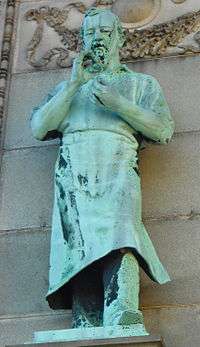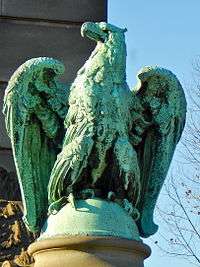Smith Memorial Arch
.jpg)
.jpg)

Smith Memorial Arch is an American Civil War monument at South Concourse and Lansdowne Drive in Philadelphia, Pennsylvania. Built on the former grounds of the 1876 Centennial Exposition, it serves as a gateway to West Fairmount Park. The Memorial consists of two colossal columns supported by curving, neo-Baroque arches, and adorned with 13 individual portrait sculptures (2 equestrians, 3 figures, and 8 busts); two eagles standing on globes; and architectural reliefs of 8 allegorical figures.
History
In 1891, Richard Smith (1821-1894), a wealthy Philadelphia electroplate and type founder, created a will that provided $500,000 ($13,190,741 today[1]) for a memorial arch to be adorned with portraits of Pennsylvania's Civil War military and naval heroes. Smith deposited the model and designs for the memorial with the Fidelity Insurance Trust and Safe Deposit Company and stipulated that: Fidelity president John B. Gest handle his request, that the architectural designs and construction be handled by Philadelphia architect James H. Windrim, and that the selection and supervision of sculptors for the specified portraits should be handled by the Fairmount Park Art Association (now the Association for Public Art).[2]
The will went into effect upon the death of Smith's wife in 1895, but it was not until 1897 that the Fairmount Park Art Association began to select the sculptors. The initial commissions were awarded on May 8, 1898, and it took until 1912 before the last sculpture was completed and installed on the arch.[3]
The estate of Richard and Sarah Smith also funded the creation of Smith Memorial Playground & Playhouse, in East Fairmount Park.
Sculpture
Statues



- Major General George Gordon Meade by Daniel Chester French (atop south column).[4]
- Major General John Fulton Reynolds by Charles Grafly (atop north column).[5]
- Richard Smith (donor of the Memorial) by Herbert Adams (on pedestal of north column).[6]
Equestrian statues
- Major General George B. McClellan by Edward Clark Potter (atop south pier).[7]
- Major General Winfield Scott Hancock by John Quincy Adams Ward (atop north pier).[8]
Busts
- Major General John F. Hartranft by Alexander Stirling Calder.[9][10]
- Major General Samuel W. Crawford by Bessie Potter Vonnoh.[11]
- General James Addams Beaver by Katherine M. Cohen.[12][13]
- Admiral David Dixon Porter by Charles Grafly.[14]
- Admiral John A. B. Dahlgren by George Bissell.[15]
- Governor Andrew Gregg Curtin by Moses Jacob Ezekiel.[16]
- James H. Windrim (architect of the Memorial) by Samuel Murray.[17]
- John B. Gest (executor of Richard Smith's estate) by Charles Grafly.[18]
Other sculpture
- Two eagles standing on globes by John Massey Rhind.
- Eight bas-relief allegorical figures by
- The Memorial's frieze is carved with the names of 84 Pennsylvania veterans.
- The Memorial's inscription reads:
THIS
IN UNITY.[19]
MONUMENTAL MEMORIAL
PRESENTED BY
RICHARD SMITH
TYPE FOUNDER
OF PHILADELPHIA –
IN MEMORY OF
PENNSYLVANIANS WHO
TOOK PART IN THE CIVIL WAR
THEIR STRIFE WAS NOT FOR
AGGRANDIZEMENT AND WHEN
CONFLICT CEASED THE NORTH
WITH THE SOUTH UNITED AGAIN
TO ENJOY THE COMMON HERITAGE
LEFT BY THE FATHERS OF OUR
COUNTRY RESOLVING THAT
THEREAFTER ALL OUR PEOPLE
SHOULD DWELL TOGETHER
References
Coordinates: 39°58′39″N 75°12′24″W / 39.97750°N 75.20667°W
- ↑ Federal Reserve Bank of Minneapolis Community Development Project. "Consumer Price Index (estimate) 1800–". Federal Reserve Bank of Minneapolis. Retrieved October 21, 2016.
- ↑ Smith Memorial Arch from Historic American Buildings Survey.
- ↑ Smith Memorial from SIRIS.
- ↑ Meade statue from Flickr.
- ↑ Reynolds statue from Philadelphia Public Art.
- ↑ Smith statue from Philadelphia Public Art.
- ↑ McClellan equestrian statue from Philadelphia Public Art.
- ↑ Hancock equestrian statue from Philadelphia Public Art.
- ↑ For the eight portrait busts, the Fairmount Park Art Association decided that a uniform base was needed. The base designed by Alexander Stirling Calder for his bust of General Hartranft was chosen as the standard for all of the busts on the arch. Source: SIRIS.
- ↑ Hartranft bust from Philadelphia Public Art.
- ↑ Crawford bust from Philadelphia Public Art.
- ↑ Beaver bust from Philadelphia Public Art.
- ↑ Katherine M. Cohen from AskArt.
- ↑ Porter bust from Philadelphia Public Art.
- ↑ Dahlgren bust from Philadelphia Public Art.
- ↑ Curtin bust from Philadelphia Public Art.
- ↑ Windrim bust from Philadelphia Public Art.
- ↑ Gest bust from Philadelphia Public Art.
- ↑ Inscription from Flickr.
Sources
- Fairmount Park Art Association, Sculpture of a City: Philadelphia's Treasures in Bronze and Stone (New York: Walker Publishing Company, 1974), pp. 168–179.
- Penny Balkin Bach, Public Art in Philadelphia (Philadelphia: Temple University Press, 1992), p. 208.
External links
| Wikimedia Commons has media related to Smith Memorial Arch. |
- Smith Memorial Arch, from Philadelphia Public Art
- Smith Memorial Arch, from Historic American Buildings Survey
- Smith Memorial Arch, from Smithsonian Institution Research Information System
- Smith Memorial Arch, from Association for Public Art